|
< Earlier Kibitzing · PAGE 3 OF 3 ·
Later Kibitzing> |
Nov-24-07
 | | Jimfromprovidence: To all of you 29 Nxh6 proponents, can’t black just play 31…Rf8, after 30 … Rxf7 31 Re8+ since the queen protects the rook? |
|
| Nov-24-07 | | MostlyAverageJoe: <Jimfromprovidence: To all of you 29 Nxh6 proponents, can’t black just play 31…Rf8> This is exactly what the black should play to refute 29. Nxh6. To quote myself: <Tempting double check Nxh6+ accomplishes nothing except removing the black K from the unpleasant location on g8.> Imagining that the rook is still pinned must be the same kind of the mental block that caused me to dismiss the royal fork administered by the black in the game (the fork does not work in the original position, but does after Rf4). |
|
| Nov-24-07 | | MostlyAverageJoe: <zb2cr> Yes, you're right that the black N can be trapped. One more nail in the coffin. <Jimfromprovidence> In your continuation, 39.Nc5 might improve white's chances compared to 39.b8=Q. In any case, this is another of those endgames where engines are of little help, just like the one from last week (Kupreichik vs Sveshnikov, 1986, which I am STILL trying to figure out). This continuation looks good (with the complete line for reference): <29. Rf4 Bg2+ 30. Kxg2 Ne1+ 31. Kf1 Nxc2 32. Ne5+ Kh7 33. Bxc2+ g6 34. Rxf6 Rxf6 35. cxb7 Bc7 36. Nd7 Rc6 37. Kg2 h5 38. Be4 Ra6> 39. Nc5 Ra5 40. Ne6 Bb8 41. Nf8+ Kh6 42. Nd7 Ba7 43. c4 Rxa4 44. Bd5 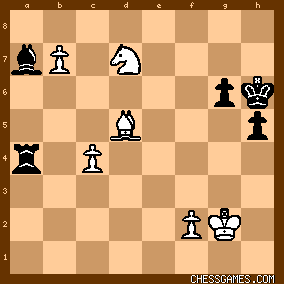
click for larger viewAt this point, Deep Shredder valuation is 2.55 - a quite reliable indication of white's win, much better than the measly 1.00 in the last week's game. Intuitively, it seems a good idea for white to try to keep 2 pawns for a while longer. |
|
| Nov-24-07 | | MostlyAverageJoe: <Samagonka: Like <Confuse>, I'm also confused! What if Qxg6?! White can pick up the rook but that's it then, or what? Fill me in somebody!> The answer to <Confuse> was provided BEFORE your post. Perhaps you had too much samagonka on Saturday ?-)
For those wondering what it is aboute: Russian "samagonka" == "moonshine" in English. |
|
| Nov-24-07 | | SAINTAMANT: I see White finishing off Black with
29) Ng5++ Kh8 Rf4!!
if ..QxN RXR checkemate.
Im l correct?? |
|
| Nov-24-07 | | SAINTAMANT: l missed the continuation of Bg2+ KXB
Ne1+ Kf1 NxC2 |
|
| Nov-24-07 | | dabbler: <SAINTAMANT> Not correct because Black can play 30...Bg2+. |
|
| Nov-24-07 | | goldenbear: I had the main line of this completely worked out in about 30 seconds, whereas I completely missed Tuesday's puzzle. I find puzzles like this much easier than puzzles where there are several good options and you have to figure out which is best. I have no idea why. |
|
Nov-24-07
 | | Jimfromprovidence: <MostlyAverageJoe> <In your continuation, 39.Nc5 might improve white's chances compared to 39.b8=Q.> <In any case, this is another of those endgames where engines are of little help, just like the one from last week (Kupreichik vs Sveshnikov, 1986, which I am STILL trying to figure out). This continuation looks good (with the complete line for reference):
<29. Rf4 Bg2+ 30. Kxg2 Ne1+ 31. Kf1 Nxc2 32. Ne5+ Kh7 33. Bxc2+ g6 34. Rxf6 Rxf6 35. cxb7 Bc7 36. Nd7 Rc6 37. Kg2 h5 38. Be4 Ra6> 39. Nc5 Ra5 40. Ne6 Bb8 41. Nf8+ Kh6 42. Nd7 Ba7 43. c4 Rxa4 44. Bd5> I played out your continuation on CM 3000 software (15 years old). The game ended up with a bishop and knight advantage for white and took 40 moves to obtain mate. Thanks for the assist.
BTW, I respectfully disagree with your position on last Saturday's match. (Regardless of the value of chess software in helping solve that particular endgame, I believe white wins with correct play after some initial forcing moves. I have made additional posts to that effect). |
|
| Nov-24-07 | | RandomVisitor: After
<29. Rf4 Bg2+ 30. Kxg2 Ne1+ 31. Kf1 Nxc2 32. Ne5+ Kh7 33. Bxc2+ g6 34. Rxf6 Rxf6 35. cxb7 Bc7 36. Nd7 Rc6 37. Kg2 <Kh8>>1: Evgenij Ermenkov - Gennadi Sagalchik, Primorsko (Bulgaria) 1991
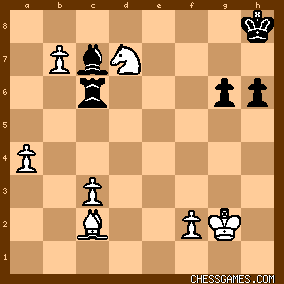
click for larger viewAnalysis by Rybka 2.3.2a mp up:
(28-ply)
1. ² (0.60): 38.a5 Ra6 39.c4 Rxa5 40.c5 Kg7 41.c6 Rb5 42.Ba4 Rb2 43.Bb3 Bd6 44.Nc5 Rxf2+ 2. ² (0.36): 38.b8Q+ Bxb8 39.Nxb8 Rxc3 40.Bxg6 Rc4 41.f3 Rxa4 42.Be4 Kg7 43.Nd7 Ra1 44.Kg3 Rg1+ |
|
| Nov-24-07 | | MostlyAverageJoe: <Jimfromprovidence: BTW, I respectfully disagree with your position on last Saturday's match.> Hey, that's OK. I change that position about once every two days :-) |
|
| Nov-24-07 | | MostlyAverageJoe: <RandomVisitor: After <... 37. Kg2 <Kh8>>> Interesting. Up to 24 plies, Deep Shredder consistently preferred 37... h5. I'll do some sliding on your line. |
|
| Nov-24-07 | | patzer2: <RV> What is Rybka's answer for <29. Rf4 Bg2+ 30. Kxg2 Ne1+ 31. Kf1 Nxc2 32. Ne5+ Kh7 33. Bxc2+ g6 34. Rxf6 Rxf6 35. cxb7 Bc7> 36. Nxg7? Fritz 8 shows 36. Nxg7 is a win (+2.03 at 17 depth) , but apparently Rybka has an answer if it considers 36. Nd7 stronger but only +0.60 advantage at 28-depth! |
|
| Nov-24-07 | | MostlyAverageJoe: <patzer2> RV's analysis starts after the line I posted in response to you, where I mentioned: < 37. Kg2 and black has a couple of fairly close choices in this position (with ... h5 probably the best)> RV picked up another plausible continuation, <37... Kh8> and his analysis followed from there. I suppose Rybka disagreed with the idea of h5 being the best. Anyway, the choice between 36. Nxg7 and 36. Nd7 did not come from Rybka, but from Deep Shredder 11. For what it is worth, here is the 28-ply analysis from Shredder: (+1.94) 36. Nd7 Rc6 37. Kg2 Kh8 38. a5 Ra6 39. c4 Rxa5 40. b8=R Bxb8 41. Nxb8 Kg7 42. Nd7 g5 43. c5 Kf7 44. c6 Ke6 45. Kg3 h5 46. f3 Kd6 47. Be4 Ke6 48. Nb6 Rc5 49. Na8 Kd6 (+1.60) 36. Nxg6 Kg7 37. Ne7 Ra6 38. c4 Ra7 39. Be4 Kf7 40. Nf5 Rxa4 41. Bd5 Kf6 42. Nxh6 Rb4 43. Ke2 Rb3 44. Kd2 Kg5 45. Kc2 Rxb7 46. Nf7 Kf6 47. Bxb7 Kxf7 48. c5 Kf6 Note that I would not trust more than 9 plies of the above lines; as a rule of thumb only about 1/3rd of the lines shown by the engines is reasonably trustworthy, sometimes not even that much. The lines must be confirmed by sliding forward/backward analysis, which, alas, is very time consuming. <RandomVisitor: ... (+0.60) 38.a5 Ra6 39.c4 Rxa5 40.c5> Shredder considers 40.c5 to be a blunder (+1.40) and prefers 40.b8=Q (+1.94, 24 plies). More inaccuracies follow, and the end of your line gets (+0.90) valuation (22-ply). |
|
| Nov-24-07 | | MostlyAverageJoe: A quick note before someone gets upset that this discussion is turning into engine slugfest. I suppose there is little doubt that white wins even if black played the stronger move 32...Kh7 instead of the immediately losing 32...Kh8. What I find very interesting here, though, is that the win that may appear obvious to humans, is by no means obvious to computer engines. All it goes to show that there is still lots of areas for software to improve and for humans to dominate (for the next couple of years). This is why I am still adding fuel to the engine-based discussion :-). |
|
| Nov-24-07 | | Everett: <patzer2> Did you happen to see, in your 29.cxb7 line... 29.cxb7! Bc7 30.Rf4!! Bg2+ 31.Kxg2 Ne1+ 32.Kf1 Qa3+?? Still loses, after 33.Kxe1, but in a time scramble anything can happen. Thanks for all your work on these puzzles! We greatly benefit! |
|
| Nov-24-07 | | patzer2: <Mostly Average Joe> Thanks for the explanation. Thought for a while there Rybka's 28-ply on <RV>'s monster processor had found a cook to today's puzzle. |
|
| Nov-24-07 | | Everett: I know that everyone is using this line
<29. Rf4 Bg2+ 30. Kxg2 Ne1+ 31. Kf1 Nxc2 32. Ne5+ Kh7 33. Bxc2+ g6 34. Rxf6 Rxf6 35. cxb7 Bc7 36. Nd7 Rc6 37. Kg2> to look at the endgame, but my comp kicked out 35...Rb6 and I think white wins with 36.Be4 Bxc3? (36...Bc7 is certainly safer) 37.Nc4 Rb4 38.Bd5 Bd4 (38...Rxd4?? seeking an OCB ending is an idea, if it doesn't let the b-pawn promote next move) 39.a5 h5 40.a6 Rb8+ 41.Kg2 Kg7 42.Nb6! is a winning interference to promote a pawn. Sure there are improvements... |
|
| Nov-25-07 | | MostlyAverageJoe: <Everett: ... my comp kicked out 35...Rb6> Rb6 gives up a black pawn for nothing, and the connected g+h pawns are Black's only counter play. This is what would happen: 35. ... Rb6? 36. Bxg6+ Kh8 37. Be4 Rb3 38. Bd5 Rb1+ 39. Kg2 Bc7 40. Nd7 Ra1 41. Bc6 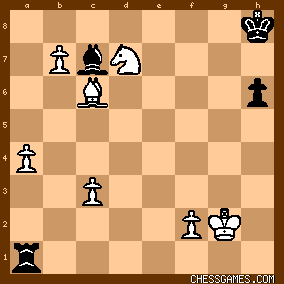
click for larger viewand what is black to do now? His bishop is as good as gone, and it sure seems that the rook will have to be given up for the a-pawn. |
|
| Nov-25-07 | | Everett: Thanks <MAJ>. I should say there was one other nuance in the position. After <29. Rf4 Bg2+ 30. Kxg2 Ne1+ 31. Kf1 Nxc2 32. Ne5+ Kh7 33. Bxc2+ <Kg7> 34. Rxf6 Rxf6 35. cxb7 Rb6> ...the g6 pawn in not enprise.
Why is black playing g6 on 33 anyway? Why is this better than Kg7? |
|
| Nov-25-07 | | RandomVisitor: <patzer2><What is Rybka's answer for <29. Rf4 Bg2+ 30. Kxg2 Ne1+ 31. Kf1 Nxc2 32. Ne5+ Kh7 33. Bxc2+ g6 34. Rxf6 Rxf6 35. cxb7 Bc7> 36. Nxg7?>I assume you mean Nxg6 (29-ply)
1: Evgenij Ermenkov - Gennadi Sagalchik, Primorsko (Bulgaria) 1991
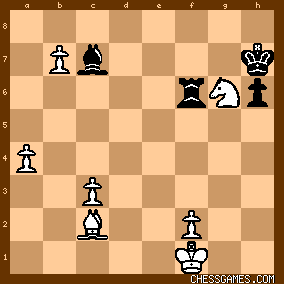
click for larger viewAnalysis by Rybka 2.3.2a mp up:
1. ± (0.77): 36...Kg7 37.Ne7 Ra6 38.c4 Ra7 39.Be4 Kf8 40.Nf5 Rxa4 41.Bd5 Ra6 42.Ke2 Rf6 43.Nd4 2. ± (0.99): 36...Rb6 37.Ne7+ Kg7 38.Be4 Ra6 39.Nd5 Bb8 40.c4 Rxa4 41.Nb6 Rb4 42.Nd7 Bc7 43.Bd5 (, 25.11.2007)
|
|
| Nov-25-07 | | MostlyAverageJoe: <Everett> I think you meant Kg8 (black cannot play Kg7 instead of g6, because the pawn is still on g7). So, the line is 29. Rf4 Bg2+ 30. Kxg2 Ne1+ 31. Kf1 Nxc2 32. Ne5+ Kh7 33. Bxc2+ and now if 33 ... Kg8, then:
34. Bb3+ Kh7 35. Rxf6 Rxf6 36. cxb7 Bc7 37. Nd7
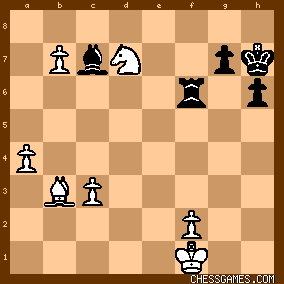
click for larger viewand the pawn-bishop exchange is immediate, simplifying the game greatly. Note that the black king sits on a light square, so any attack on the white bishop enables its escape to c3 with a tempo - so after b8=Q BxQ NxB Rb6 Bc2+, the white knight escapes to safety on d7. Oh, well. Enough time on this game. I have to file it as one of the "engine killer" puzzles. |
|
| Nov-25-07 | | D4n: This is a nice end game for white. |
|
| Nov-25-07 | | patzer2: <RV> Thanks for the analysis! Looks like I'll need to put Rybka and a quad processor on my wish list. |
|
| Nov-25-07 | | Everett: *sigh*
I was wondering about 29. Rf4 Bg2+ 30. Kxg2 Ne1+ 31. Kf1 Nxc2 32. Ne5+ Kh7 33. Bxc2+ Kg8 34. Bb3+ Kh7 35. Rxf6 Rxf6 36. cxb7 Rb6 White must spend the time protecting the b-pawn with 37.Bd5 Bc7 (...Bxc3 38.Nd7 wins) 38.Nd7 leads to a slightly different endgame than the one analyzed. |
|
 |
 |
|
< Earlier Kibitzing · PAGE 3 OF 3 ·
Later Kibitzing> |





